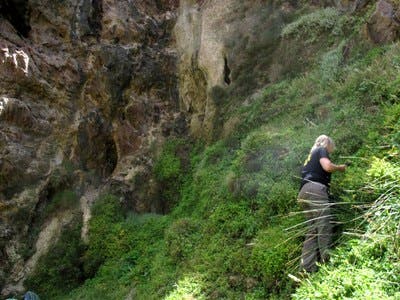Carbohydrates from starchy plants are a vital component of our nutrition, and yet researchers aren’t exactly sure when and how humans started consuming it. Now, a new study of charred food remains from hearths finds that anatomically modern humans were consuming it at least 120,000 years ago.

Starch is a weird carbohydrate. It’s produced by almost all plants as a form of energy storage. Although in its pure form it’s white, tasteless, and odorless, it is the most common carbohydrate in the human diet and is contained in most staple foods all around the world. Raw starch is digested poorly by humans, but in its cooked formed, it becomes much more accessible and nutritious.
It’s not exactly clear when humans started consuming starch, but a new study provides an important clue in that regard.
Archaeologists analyzing Klasies River, a famous early human occupation site on the Cape coast of South Africa found a series of small ancient hearths, around 30 cm (1 foot) in diameter. When they analyzed these hearths, they found evidence that humans were roasting and eating plant starches, such as those from tubers and rhizome.
“Our findings provide the archaeological evidence that has previously been lacking to support the hypothesis that the duplication of the starch digestion genes is an adaptive response to an increased starch diet,” says lead author Cynthia Larbey of the Department of Archaeology at the University of Cambridge.
“This is very exciting. The genetic and biological evidence previously suggested that early humans would have been eating starches, but this research had not been done before. So, at Klasies River we took a team approach, firstly to find and analyse undisturbed hearths and secondly, to take botanical samples from those hearths and compare findings.”
Archaeologist have long believed that humans started consuming starch way before farming, but most evidence for this was circumstantial — this is the first piece of hard evidence to support this hypothesis. Furthermore, previous evidence has indicated that around this period, humans were starting to use more advanced tools to hunt, and were presumably eating more meat. But despite this, their diet still consisted of high amounts of plants.
“The results show these small ashy hearths were used for cooking food and starchy roots and tubers were clearly part of their diet, both from the earliest levels at around 120,000 years ago through to 65,000 years ago. So, despite changes in hunting strategies and stone tool technologies, they were still cooking roots and tubers.”
There’s also an important effect of mankind’s ability to cook and eat starches: it enabled early humans to migrate and adapt to different environments, colonizing new regions of the world.
Study: Larbey et al. Cooked starchy food in hearths ca. 120 kya and 65 kya (MIS 5e and MIS 4) from Klasies River Cave, South Africa. Journal of Human Evolution, 2019; 131: 210 DOI: 10.1016/j.jhevol.2019.03.015





